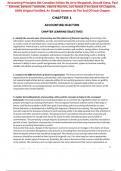Exam (elaborations)
Accounting Principles 8th Canadian Edition By Jerry Weygandt, Donald Kieso, Paul Kimmel, Barbara Trenholm, Valerie Warren, Lori Novak (Test Bank All Chapters, 100% Original Verified, A+ Grade) Answers At The End Of Each Chapter
Accounting Principles 8th Canadian Edition By Jerry Weygandt, Donald Kieso, Paul Kimmel, Barbara Trenholm, Valerie Warren, Lori Novak (Test Bank All Chapters, 100% Original Verified, A+ Grade) Answers At The End Of Each Chapter
[Show more]



